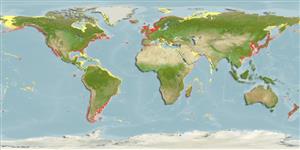Common names from other countries
Classification / Names / Names
ماع يماسا | فدارتم | Catalog of Fishes (gen., sp.) | ITIS | CoL | WoRMS
Environment: milieu / climate zone / depth range / distribution range
يسانش موب
; روش بل; قمع تارييغت 3 - 58 m (Ref. 112705). Tropical
Cosmopolitan. Tropical to polar.
Length at first maturity / Size / Weight / نس
Maturity: Lm ? range ? - ? cm Max length : 6.0 cm TL يسنج صاوخ نودب / رن سنج; (Ref. 7882)
Species' maximum length from the Belgian part of the North Sea (Ref. 7882). Tubiculous (Ref. 112705). Found in estuarine and inshore areas (Ref. 96352) along the coastal zone in almost all sediment types from fine to coarse sand with mud content of 0 to 90% (Refs. 2780, 7882, 96352). Associated with organic pollutants (Ref. 96352). Tube-building species (Ref. 96377). A surface-deposit microvore that feeds on organic detritus (Ref. 96352).
Life cycle and mating behavior
غولب | لثم دیلوت | یزیر مخت | اه مخت | Fecundity | )ورال ( دازوت
Members of the class Polychaeta are mostly gonochoric (sexual). Mating: Females produce a pheromone attracting and signalling the males to shed sperm which in turn stimulates females to shed eggs, this behavior is known as swarming. Gametes are spawned through the metanephridia or body wall rupturing (termed as "epitoky", wherein a pelagic, reproductive individual, "epitoke", is formed from a benthic, nonreproductive individual, "atoke"). After fertilization, most eggs become planktonic; although some are retained in the worm tubes or burrowed in jelly masses attached to the tubes (egg brooders). Life Cycle: Eggs develop into trocophore larva, which later metamorph into juvenile stage (body lengthened), and later develop into adults.
یلصا ذخآم
عجارم | هدننك گنهامه | ناراكمه
Salazar-Vallejo, S.I. and M.H. Londoño-Mesa. 2004. (Ref. 8159)
NCUI زمرق تسرهف رد تيعضو (Ref. 130435)
ستياس رظن زا تيعضو (Ref. 108899)
Not Evaluated
Not Evaluated
یناسنا هدافتسا
| FishSource |
اهرازبا
رتشيب تاعالطا
Age/Sizeدشرنزو - لوطلوط - لوطيسانش تخير)ورال ( دازوتيناوارف
يتنرتنيا عبانم
Estimates based on models
تميق هقبط
Unknown.
